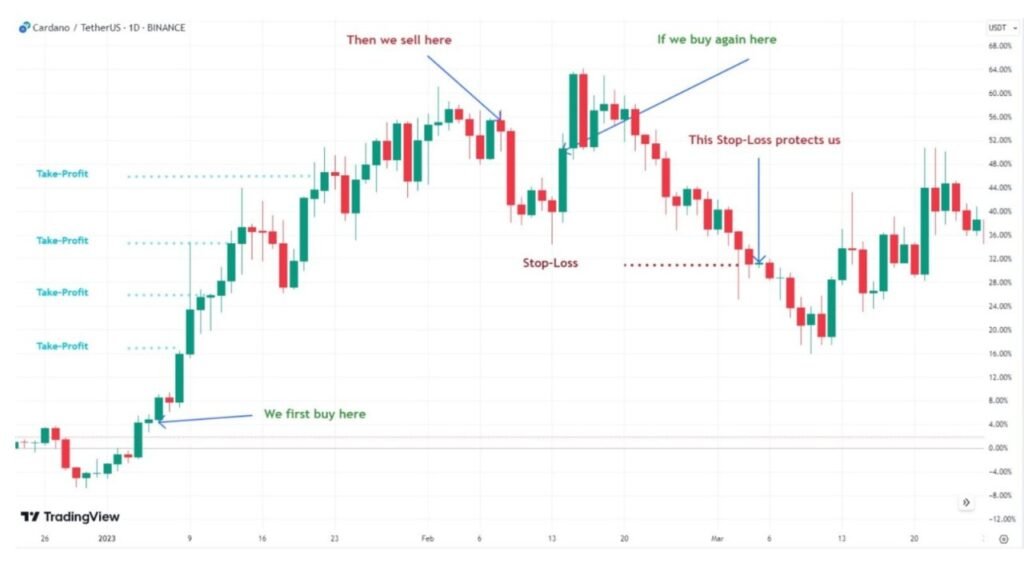Cryptocurrency trading strategies have become essential for investors seeking to navigate the volatile and exciting world of digital currencies. This article will explore various cryptocurrency trading strategies, providing you with the knowledge and tools needed to make informed trading decisions. Whether you’re a novice or an experienced trader, understanding these strategies can significantly impact your success in the cryptocurrency market.
Introduction to Cryptocurrency Trading Strategies
Cryptocurrency trading strategies are systematic methods used by traders to buy and sell cryptocurrencies.

These strategies are designed to maximize profits and minimize risks by analyzing market conditions, price movements, and other relevant factors. With the rapid growth of the cryptocurrency market, having a well-defined trading strategy is crucial for success.
Why Are Cryptocurrency Trading Strategies Important?
- Risk Management: Effective cryptocurrency trading strategies help traders manage risks by setting clear entry and exit points, stop-loss orders, and position sizes.
- Maximizing Profits: By following a structured approach, traders can identify profitable opportunities and avoid impulsive decisions.
- Consistency: A well-defined strategy ensures consistency in trading, reducing emotional biases and increasing the likelihood of long-term success.
Types of Cryptocurrency Trading Strategies
1. Day Trading
Day trading is one of the most popular cryptocurrency trading strategies. It involves buying and selling cryptocurrencies within a single trading day. Day traders aim to capitalize on short-term price fluctuations and typically close all positions by the end of the day to avoid overnight risks.
Key Points:
- High Frequency: Multiple trades within a day.
- Technical Analysis: Utilizes charts and technical indicators.
- Time Commitment: Requires constant monitoring of the market.
2. Swing Trading
Swing trading is a medium-term cryptocurrency trading strategy that involves holding positions for several days or weeks. Swing traders aim to capture price swings within a larger trend. This strategy relies on technical analysis and sometimes incorporates fundamental analysis.
Key Points:
- Trend Following: Focuses on short-to-medium-term trends.
- Technical Indicators: Uses tools like moving averages and RSI.
- Patience: Less time-intensive than day trading but requires patience.
3. Scalping
Scalping is a short-term cryptocurrency trading strategy that aims to make small profits from numerous trades throughout the day. Scalpers hold positions for a few seconds to minutes, taking advantage of small price movements.
Key Points:
- High Frequency: Dozens to hundreds of trades per day.
- Small Profits: Focuses on small gains per trade.
- Quick Decisions: Requires fast decision-making and execution.
4. Position Trading
Position trading is a long-term cryptocurrency trading strategy where traders hold positions for months or even years. This strategy is based on the belief that the cryptocurrency will increase significantly in value over time.
Key Points:
- Long-Term: Holds positions for extended periods.
- Fundamental Analysis: Relies heavily on fundamental factors.
- Low Frequency: Fewer trades compared to other strategies.
Implementing Cryptocurrency Trading Strategies
1. Technical Analysis
Technical analysis is a critical component of most cryptocurrency trading strategies. It involves analyzing price charts and using various indicators to predict future price movements.
Popular Technical Indicators:
- Moving Averages: Helps identify trends and potential reversals.
- Relative Strength Index (RSI): Measures the speed and change of price movements.
- Bollinger Bands: Indicates volatility and potential price breakouts.
2. Fundamental Analysis
Fundamental analysis evaluates the intrinsic value of a cryptocurrency by examining factors such as technology, team, market demand, and regulatory environment. This approach is often used in long-term trading strategies.
Key Factors to Consider:
- Technology: Assess the underlying technology and its potential.
- Team: Evaluate the experience and credibility of the team.
- Adoption: Look at the level of adoption and use cases.
- Regulation: Consider the impact of regulatory developments.
3. Sentiment Analysis
Sentiment analysis involves gauging the market sentiment by analyzing news, social media, and other sources. It helps traders understand the overall mood of the market, which can influence price movements.
Tools for Sentiment Analysis:
- News Aggregators: Track news from multiple sources.
- Social Media Monitoring: Analyze sentiment on platforms like Twitter and Reddit.
- Sentiment Indicators: Use tools that aggregate sentiment data.
Risk Management in Cryptocurrency Trading Strategies
Risk management is a crucial aspect of successful cryptocurrency trading strategies. It involves identifying, assessing, and mitigating risks to protect your capital.
1. Setting Stop-Loss and Take-Profit Levels
Stop-loss and take-profit orders are essential tools for managing risk. A stop-loss order automatically sells a cryptocurrency when it reaches a predetermined price, limiting potential losses. A take-profit order locks in profits by selling the cryptocurrency when it reaches a specified price.
2. Diversification
Diversifying your portfolio can help spread risk across multiple assets. Instead of investing all your capital in one cryptocurrency, consider holding a mix of different cryptocurrencies.
Diversification Tips:
- Variety: Include cryptocurrencies with different use cases and risk profiles.
- Rebalancing: Periodically rebalance your portfolio to maintain desired asset allocation.
- Research: Conduct thorough research before adding new cryptocurrencies to your portfolio.
3. Position Sizing
Position sizing involves determining the amount of capital to allocate to each trade. It helps manage risk by ensuring that no single trade can significantly impact your overall portfolio.
Position Sizing Strategies:
- Fixed Dollar Amount: Allocate a fixed dollar amount to each trade.
- Percentage of Capital: Allocate a percentage of your total capital to each trade.
- Risk-Based: Base position size on the level of risk associated with the trade.
Developing Your Own Cryptocurrency Trading Strategy
Creating a personalized cryptocurrency trading strategy involves several steps. Here’s a guide to help you get started:
1. Define Your Goals
Determine what you want to achieve with your trading. Are you looking for short-term profits, long-term growth, or a combination of both? Your goals will influence the type of strategy you choose.
2. Choose a Trading Style
Based on your goals and time commitment, select a trading style that suits you best. Whether it’s day trading, swing trading, or long-term investing, make sure it aligns with your lifestyle and risk tolerance.
3. Conduct Thorough Research
Research is critical in developing a successful trading strategy. Stay informed about market trends, news, and developments in the cryptocurrency space. Use a combination of technical, fundamental, and sentiment analysis to make informed decisions.
4. Test Your Strategy
Before implementing your strategy with real money, test it using historical data or a demo account. This will help you understand its effectiveness and make necessary adjustments.
5. Monitor and Adjust
Once you start trading, continuously monitor your strategy’s performance. Be prepared to make adjustments based on market conditions and your trading results.
Conclusion
Cryptocurrency trading strategies are essential tools for anyone looking to succeed in the dynamic world of digital currencies. By understanding and implementing various strategies, traders can manage risks, maximize profits, and achieve consistency in their trading activities. Whether you’re day trading, swing trading, or investing for the long term, having a well-defined strategy is key to navigating the cryptocurrency market effectively.
Incorporate the information and tips provided in this article to develop a robust cryptocurrency trading strategy that aligns with your goals and risk tolerance. Stay informed, remain disciplined, and continuously adapt to the ever-changing market conditions. With the right approach, you can enhance your trading success and make the most of the opportunities presented by the exciting world of cryptocurrencies.




